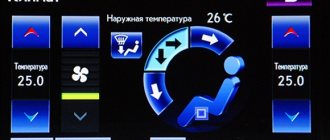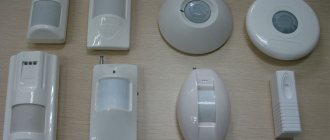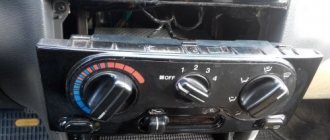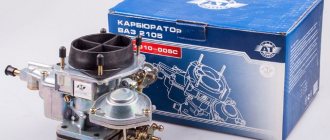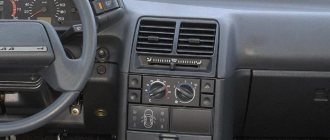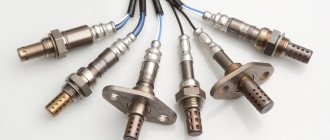The climate control unit is a set of devices that measure and maintain the climatic characteristics of indoor air within specified parameters.
The design features of the system are such that they make it possible to automatically ensure the coordinated interaction of all electronic elements responsible for regulating temperature, humidity, and chemical parameters of the air, as a result of which the goal is achieved - a comfortable atmosphere in the home. Managing climate control is not difficult and is accessible even to a child.
Features of the climate control system and its functions
A modern climate control control unit can function either autonomously or be integrated into the Smart Home system. In both cases, the “brain” of the structure, which controls every step of its operation, is the computer.
The central control unit not only collects data on the room microclimate, but also effectively saves energy by preventing simultaneous operation of devices that have mutually exclusive functions, for example, a heater and an air conditioner.
The climate control system performs the following functions:
- Control of the optimal temperature level in accordance with the specified operating mode.
- Maintaining a comfortable humidity level – no higher than 65% and no lower than 40%.
- Uniform air distribution.
- Filtration of air masses.
- Ionization and air washing.
More expensive models save energy at home and notify about the occurrence of emergency situations with the system.
The air conditioner can automatically heat or cool the air
Also, thanks to the built-in filters, it is able to purify the air. Some air conditioner models are capable of humidifying and “mixing” room air with “fresh” air.
REFERENCE
Some air conditioners have a multi-split system, which works with several units at once and is capable of maintaining personal climate characteristics of the air in all rooms separately.
You must understand that air conditioning and climate control are completely different things. Although they have similar functions, the climate control functionality is much more extensive.
An air conditioner is a single device that includes many options. But in essence, the air conditioner is responsible for its own operation and cannot replace the entire utility network. The air conditioner cannot be the main source of heating the apartment as a whole. It cannot provide access to adequate fresh air, as well as control the operation of other devices in the system.
The difference between the control system and the air conditioner
Climate control is primarily a control center for devices. Unlike an air conditioner, it can “analyze” a situation and “make decisions.”
The air conditioner has a narrower principle of operation - it will refresh you on a hot summer day, but you can’t count on heating in the winter. Some might argue that there are reversible models that can be adjusted for “warmth.” We agree with this statement, but note that the use of this mode in split systems is possible only when the outside air temperature is above zero. And single, expensive models that heat the room in cold weather are in this case the exception rather than the widely used rule.
Sensors
Sensors include:
- Photodiodes – determine the level of external illumination;
- Input temperature sensor (external) – determines the external air temperature, mounted behind the front bumper of the car;
- Output temperature sensors – determine the temperature inside the cabin;
- Sensors that determine the temperature of the evaporator;
- Pressure sensors in the air conditioning system;
- Damper potentiometers;
- Sun sensor;
- Sun position sensor.
The operating principle of all of these sensors is based on converting the measured physical parameters into electrical signals that enter the electronic control unit.
Systems integrated by climate control
To create a comfortable indoor environment, the electronic climate control control unit combines into one a number of household appliances - air conditioning and supply and exhaust ventilation, ionizer and heating radiators, “warm floors” and an air humidifier (dehumidifier).
How does the climate control system work?
- Changes in ambient temperature are adjusted remotely. Possible range is 18o-30o. Sensors automatically change the temperature according to the specified parameters.
- Air distribution. Thanks to the presence of vertically and horizontally directed barrier devices that function like blinds, the direction of air masses is regulated: cold ones - up and further along the surface of the ceiling, warm ones - from top to bottom.
- Change in humidity. Regulation of the humidity level in the room is achieved by introducing special moisture supply nozzles into the ventilation network. Excess water is removed by desiccant elements.
- Air purification from mechanical impurities and microbes. It is carried out by a combination of an LED emitter and air filters.
- Air ionization. Changing the ionic composition of the air mixture is provided by a built-in needle ionizer.
Possible faults
Like any complex device, the climate control of the Lada Grant tends to fail, and in order to save time on detecting a breakdown, it is worth knowing the possible malfunctions of this system. As a rule, breakdowns occur in the heating mode (so important for the extreme conditions of the Russian climate). Already in the second or third year of operation, a significant decrease in the supply of hot air or a failure in the system for switching the flow of hot and cold air may be observed.
Such disturbances in the system occur either due to clogged filters or due to a defective fan. It is often prone to failure due to the fact that it is made of fragile material. To restore the operation of the system, you should replace the filters, and if after that you notice a drop in the speed of the electric motor, then you need to check its voltage. The ideal voltage is 0.5 V.
If the reading is below this figure, it means the contact in the fan is broken. If the voltage is normal, but the problem is obvious, then you will have to repair or even replace the electric motor. It also happens that it’s hot outside and you want frosty freshness. You get into the car in confidence that the climate control will not let you down. But when you turn on the system, you realize that instead of the expected cold breeze, hot air from the stove is coming into the cabin.
What does it mean to change places of cold and heat in this case? This means that the damper drive has become unusable: a break, a cable, a switch, etc. It is also possible that the antifreeze level has dropped, which disrupts the coolant circulation.
And finally, the third reason for such a failure may be a simple clogging of the radiator tubes. To fix the problem, you need to either replace the tubes or clean them, or normalize the antifreeze level, or put the damper in order. Very often the climate system malfunctions due to an air lock. It can be removed in two ways:
- drive the front wheels onto a small hill and run the engine at high speeds;
- Drain and refill with new coolant.
The principle of operation of climate control in an apartment
Installing climate control in a smart home allows you to solve the problem of creating comfortable living conditions for a person in a single apartment.
The “thinking” system is able to maintain the optimal temperature level for each room. This way the air in the children's room and bathroom can be warmed up more than in the kitchen and living room. You can reduce the heating intensity at night or during the working day while no one in the household is at home.
What elements of the system are used to regulate climate?
- Fan coil, servo drives – heating function control.
- Air valves, air flow regulators – ensuring ventilation.
- Thermostats and climate controllers – for the operation of the “warm floor” system.
The heat exchange function is provided by water of different temperatures supplied to the circuits of the structure. The temperature background of the room is finally formed by the degree of heating of the working fluid, which is sent to the fan coil units, which directly release heat into the house.
The ventilation system supplies already purified street air to the devices. The sensors signal to the control panel when a filter is dirty and it is replaced in a timely manner, thereby preventing the failure of the entire structure due to the increased voltage level.
Hygrostats level out the humidity in the room . The devices are programmed in such a way that when an indicator is triggered indicating a decrease in the moisture content in the air, the humidification system starts, and when overhumidification is detected, the dehumidifier starts.
How it works: climate control
Air conditioners and heaters operating in cars sometimes cause some inconvenience. If you turn on the air conditioner in the car to cool mode, after a while it will become unnaturally cold. A similar situation is observed with the stove: if you do not turn it off in time, it will become unbearably hot. In general, they need to be constantly monitored, which is inconvenient when sitting behind the wheel.
The thing is that the stove and air conditioner do not know how to measure the temperature in the cabin.
The name “climate control” speaks for itself. This system constantly monitors the temperature in the cabin. The driver only needs to set the desired one (comfortable conditions for a person are considered to be 22-24 0C). A climate control unit is a device that combines a heater and an air conditioner.
Sensors are installed inside the machine to maintain a constant temperature. When the sensors detect a decrease in temperature, the heater automatically turns on; If it gets hot, the air conditioner starts working. In fact, the operating principle and design of climate control is much more complex than it seems at first glance.
In a simplified way, the operation of climate control can be described as follows: a fan blows air into the evaporator (one of the important parts of the air conditioner) from the street, which is cooled and dried in it. Then the air flow enters the stove. In it, it warms up sufficiently, and then goes to the salon. The main job of climate control is to mix warm and cold air to suit the needs of the car's occupants.
In addition to internal sensors, climate control uses external temperature sensors. Based on their readings, he “decides” what exactly needs to be activated at the right moment: the air conditioner or the heater. For example, during a frosty winter trip, the climate control will turn on the heater.
The perfection of the system depends on the number of damper potentiometers, sensors, air ducts and software. “Average” climate control will immediately send warm air into the cabin during frosty periods. More advanced systems will first direct a warm stream of air onto the glass windows so that they defrost and do not fog up.
Then they will direct warm air to your feet. And only after reaching the optimal temperature will they direct warm air into your face. More expensive climate control systems analyze the quality of air taken from the street, take into account air humidity and the intensity of solar radiation.
In Auto mode, the electronics decide with what force, where and at what temperature to blow air through the car’s interior. To reach the required temperature, you need to wait a certain time, depending on the outside temperature. Currently, the climate control system can warm up the interior from 14 to 28 0C.
Climate control can be one-, two-, three- and four-zone. With dual-zone heating, the front passenger and driver are set at different temperatures. In the three- and four-zone system, rear seat passengers can create their own microclimate.
Tips for choosing climate control
Modern cars have dual-zone climate control. This may be relevant if you and your significant other have different temperature preferences. The main thing is to find out the maximum permissible temperature difference. For example, some systems cannot provide 25 0C for the driver and 17 0C for the passenger. Sometimes a difference of 2-3 0C maximum is possible. But the more modern the climate control, the more freedom both passenger and driver get.
It is common knowledge that hot air rises and cold air always falls. Therefore, the number and location of temperature sensors in the cabin will affect its operation. If, for example, the sensor is located on the roof, then the following situation is possible: the sensor located on top will “think” that the interior has already been warmed up to the desired temperature.
But in reality this is not so, and instead of warm air, cool air is supplied to passengers. A system in which sensors are located both below and above the cabin will work much better. You can find a compromise and install temperature sensors in the center, on the front panel.
And I also want to note one point, if you live near Lyubertsy, then I would like to suggest an excellent car service. Professionals in their field will meet you there, give you advice, give advice and repair your car.
eTCT
Benefits of using a climate control system in your home
The undeniable advantage of the system is its versatility. We will help residents of the northern capital appreciate all the advantages of the device; the installation of the climate system in St. Petersburg is carried out by our highly qualified installation engineers.
You will be able to pay tribute to such useful functions as:
- Operation in “freeze protection” mode.
- Possibility of adjusting individual parameters without changing the overall settings of the device.
- Warming up the room in automatic mode.
- Duration of use of the required options.
Design and operating principle
The design of the system is quite complex and consists of dozens of executive elements. The standard climate control design includes:
- Sensors installed inside and outside the vehicle. They are located in functional areas and allow you to obtain information about the temperature conditions in the machine in order to regulate the operation of the equipment. Outdoor sensors analyze air pollution and ultraviolet radiation.
- Climate control equipment acting as an actuator. Standard systems consist of an air conditioner, a heating radiator, an HVAC module, air ducts, fans, filters and additional elements necessary for normal air exchange.
- An electronic control unit designed to configure the operation of climate control, as well as read sensor parameters, analyze temperature conditions and issue commands to climate control equipment.
An example of a climate control operating diagram.
The operating principle is quite simple. The driver, using the control unit, adjusts the temperature parameters, after which the sensor readings are compared with the nominal ones. If they do not match, the heating or air conditioning is turned on to change the air parameters to the desired value. After this, the system goes into standby mode, and when changes occur in the temperature regime, the equipment automatically turns on again.
Why do they trust us?
Installation of climate control in St. Petersburg by our organization guarantees you high-quality service and post-warranty repair of equipment. Any work is performed with high quality and on time, as evidenced by reviews of our work.
A professional approach to business allows us to ensure trouble-free operation of equipment for many years.
The cost of installing a climate control system in St. Petersburg depends on the complexity of its components. Our specialists will help you calculate the required power of devices that form the climate system, taking into account the specifics of your room, so you won’t have to overpay for unused equipment capacity.
Recommendations for choosing a system
Unfortunately, you won’t find ready-made integrated solutions on the market, because each completed object is essentially unique. The system must be completed taking into account the characteristics of each connected section.
Therefore, it would not be entirely correct to recommend specific equipment. The correct advice would be a recommendation from the contractor’s company, whose employees will help:
- Create a personalized project in accordance with all current standards;
- Choose equipment that suits the parameters, style and design;
- Carry out installation and commissioning work with a guarantee of long service life and the possibility of further maintenance.
Among the companies with good ratings and reviews are:
- 220help;
- Art-In;
- Intelligencehouse;
- K-Electro.
The right option would be to purchase and install climate control simultaneously with heating systems, ventilation and other equipment that promote the necessary climatic conditions. This must be done together, because not all devices used have a control unit to which a control command can be transmitted from the main one.
Also, with a separate installation, the installation of servos for automatic control of motor elements (ventilation valves, windows in ventilation mode) is not provided. Their installation on a finished product in the house will incur additional financial and time costs. Otherwise, separately installed elements will not be included in the complete climate control system.
Don't skimp on equipment. A modern private smart home will be expensive, but this is not because of a fad. It should be understood that in such a complex system, each element must be reliable. High-quality products undergo dozens of tests before hitting the shelf. In this case, the percentage of defects is reduced to zero, plus the companies with which you enter into cooperation usually take on the responsibility of replacing defective equipment under warranty. Think about the future, buy once for more than several times for even more.
System elements are expensive. A high-quality temperature sensor can cost 10-20 thousand rubles. And for a country house you may need more than a dozen of them. The price for a central control unit is from 40 thousand rubles.
Installing climate control yourself using Arduino is, of course, welcome, but only as an educational experiment.
Get advice and be sure to ask the employee of the company installing climate control systems any questions you may have. Make your own suggestions and say how you envision your smart home in the future.
